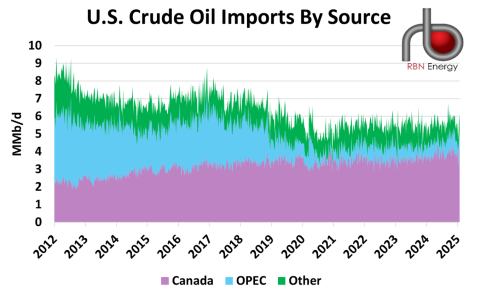The North American energy landscape has undergone significant shifts in production, infrastructure and pricing for crude oil, natural gas and NGLs over the past few years and developments within Canada have strengthened its role in the global energy trade, creating opportunities and reshaping supply chains. Yet, the market is constantly changing and today geopolitics and the potential impact of tariffs weigh heavily on the relationship between Canada and the U.S., North America’s two producing heavyweights. That shifting landscape is the subject of today’s RBN blog and a topic we’ll be discussing at our upcoming School of Energy Canada, set for August 26-27 in Calgary. Fair warning, this blog includes an unabashed advertorial for the conference.
In observance of today’s holiday, we’ve given our writers a break and are revisiting a recently published blog on Canadian and U.S. energy markets. If you didn’t read it then, this is your opportunity to see what you missed. And be sure to check out our upcoming webcast on the topic, Livin’ On The Edge, at 2:30 pm Central Time on Thursday, August 24. Click here to learn more. Happy Easter!
The U.S. and Canada have long been considered to have one of the most successful bilateral trading relationships in the world, even if those bonds are being tested like never before. Americans and Canadians are inextricably linked in a number of ways, from less-serious endeavors like sports and entertainment to more important topics like commerce and energy policy. And you can see the similarities in the hard-working people in the energy capitals of the two nations, Calgary and Houston. Of course, both cities have epic rodeo seasons. And, aside from the fact that our northern neighbors can easily handle cold weather at a level that would (and often does) simply shut down the Bayou City, we’re cut from the same kind of cloth — good-natured and business-minded.
Despite that camaraderie, trade relations between the two countries’ governments are frayed and tensions unresolved, so it’s more important than ever to understand the essential connections between the two neighbors, even if current circumstances remain difficult. The strongest energy-related links are around crude oil, the main focus for Day 1 of our upcoming conference. Canada (purple layer in Figure 1 below) supplied 3.8 MMb/d to the U.S. in 2024, or about two-thirds of total U.S. imports, with imports from OPEC countries (blue layer) and non-OPEC countries (green layer) in distant second and third place at 1 MMb/d and 740 Mb/d, respectively. Most of those Canadian imports flowed to U.S. refineries in PADD 2 (Midwest), many of which are configured specifically to process large volumes of heavy Canadian crude (see Heart of the Country).
Figure 1. U.S. Crude Oil Imports by Source. Source: RBN
Join Backstage Pass to Read Full Article









